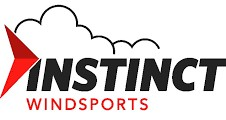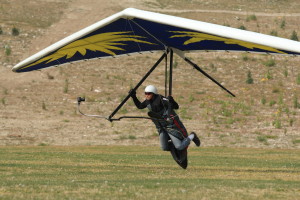FreeFlight Advice: Ya’ll Yaw!
Posted on FreeFlightAdvice.com April 7, 2014
Originally published in Hang Gliding and Paragliding Magazine
Well all hang glider pilots do anyway. Since this is something that we all experience, and few understand thoroughly, let’s take a closer look at yaw.
The best way to define what yaw is, in easy-to-imagine terms, requires you to picture a hang glider hanging from it’s kingpost. Now imagine rotating the glider left and right, so that the nose points different directions. There is no change to pitch or roll. Yaw, in flight, is when the nose points left or right of the actual direction of travel.
Yaw can be caused by turbulence in the air, but much more commonly yaw is actually caused by our inputs. In a hang glider, we have direct control over two axes; we pull in or push out for pitch, and we move left/right for roll. But we also inadvertently yaw the glider due to a phenomenon called ADVERSE YAW. Without going on an aerodynamics tangent, when we roll our glider one way- it also yaws the other. Roll right and the wing will yaw left. Roll left and the wing will yaw right. There are no ifs, ands, or buts about this… every roll input is going to be accompanied by adverse yaw, and that’s just the way it is.
Knowing this, let’s examine Pilot Induced Oscillation, or P.I.O. for short. The classic example of PIO is a glider that is yawing (and usually rolling opposite as well) and a pilot trying to correct the oscillation, moving from side-to-side. First, where does the PIO start? It can be caused by turbulence in the air, or by roll inputs by the pilot. Why does it continue is the trickier topic. Our gliders need to be somewhat unstable in order for us to steer them, and some are more so than others. Once started, some gliders are very much capable of continuing this roll/yaw oscillation we call PIO. While the pilot may have initiated it, technically this isn’t really PIO if it is self-sustaining. In most gliders, though, this oscillation will dampen itself out after a few cycles. A better example of PIO is when a glider yaws a little, and a pilot inputs roll to correct to the yaw. If a glider has yawed to the right, an instinctual correction would be to bump to the left. Well this will roll the glider left, but adverse yaw will actually yaw the glider MORE to the right. As the aerodynamics of the glider cause the nose to point back in the direction of travel, the wing will gain inertia and will continue past center, now yawing the other way. So now the glider is rolled left (from the pilot’s input), and yawing to the left. To level out, the pilot bumps right- which yaws the glider more to the left. And so the cycle continues. Even worse is if the pilot doesn’t bump, but instead holds the input until wings level. Holding it just means a bigger input is given, and by the time the wing is level and the input released, there is a LOT of inertia the other way. This is the classic example of PIO. I once heard Rob Kells call it “ringing the bell”, and that phrase has really stuck with me, as it is an excellent visualization of a pilot swinging their body from one side to the other repeatedly.
So great, we know that yaw happens. Now we know how NOT to fix it… but what should we do to fix it? Most of the time, the answer is nothing! In hang gliders we have pitch control and roll control. We can’t do any yaw inputs, so don’t create problems trying! Yaw, by definition, means the direction of travel of the wing is still straight- so just continue steering the glider where you want it to go and the yaw should dampen itself right out. If the yaw oscillation is pretty severe, slowing down to trim will almost always remedy it. Performing a turn (either direction) can also be very helpful.
There are a few things we can do to lesson the occurrence of yaw, too. First, big/drastic roll inputs will create a lot more adverse yaw than a small, smooth input. The more prone to yaw your glider is, the more you need to be very smooth and subtle in your inputs. Also, there can be certain speeds or VG settings where roll and yaw aren’t coupled as well as the other settings… practicing flying your glider (high, away from terrain or other gliders) at various speeds and configurations can help you learn what works best and what to watch out for. Another thing to avoid is combining big pitch and roll inputs- especially what is commonly referred to as a ‘slipping turn’, where the pilot pulls in and rolls at the same time. Doing this will cause a BIG adverse yaw!
There is one stage of our flights where yaw-oscillations are more likely, and more serious, than all the others…. And this is when landing. At some point you’ve probably seen someone on approach, coming in fast, barely in control as the glider oscillates all over the place. Scary stuff! It is common during landings because A) we almost always incorporate turns into our approach, and B) we almost always come in with extra airspeed. Sometimes it’s a factor of just not being used to how sensitive our gliders can be at those faster airspeeds, and the pilot is simply over-flying the glider. Other times, the yaw can be induced by our turn onto final. The turn to final may not have been smooth and coordinated, causing more adverse yaw. A ‘slipping turn’ is the worst. Once the yaw is initiated, it is most likely perpetuated by the pilot. Not to say that a really good, dialed into their glider, pilot can’t cancel yaw oscillation out… but most of us aren’t that good, so doing nothing is better than making it worse. The glider will dampen out the yaw all on it’s own… assuming you have the TIME for it to do so. I recently had a landing where I put my turn to final just a little too close to my landing spot, and the yaw wasn’t quite gone yet. Recognizing this, I had to wait longer to flare, ran out the landing, and still dropped one wingtip when I did flare. It was an excellent reminder to me: I either need to make a longer/straighter final approach, or I need to carry more speed through that low turn, giving me more time in ground-skim to wait for the oscillation to dampen out.
This series of photos shows the author making a low and slow turn that resulted in a yaw oscillation. In the first image the glider is rolling to the pilot’s left, yawing to the pilot’s right. Second image shows the glider yawed more to the pilot’s left. Third image shows the nose has swung back to the pilot’s right. Fourth image things look good, centered and balanced… but the fifth image shows there was still some yaw oscillation remaining, resulting in a dropped wing while landing. This was a fairly mellow oscillation, and yet we still see how long it took to decrease or disappear. Photos courtesy David Aldrich.
Yaw is all around us, and now that you’re thinking about it watch some landings and you’ll be amazed how prevalent it is. It can happen in any (every?) glider, but is more common in high-performance wings, because they are slippery with less drag forces to dampen the yaw, and they also tend to have more weight out at the tips (wands, sprogs, etc) so there is more inertia to carry that yaw oscillation another cycle or two or three. There is also more delay between pilot input and the glider’s response, making it harder to keep from perpetuating the oscillation once it starts.
Go up high and become more familiar with how your glider behaves in regard to yaw. Play at different speeds and VG settings. Try it prone, and try it upright. Try a ‘slipping turn’ as if you were diving into your final and see what happens. See if you can smooth that out. Then stick your landing and watch all the other gliders coming in and evaluate if yaw was a factor in their landing… and why/why not? Learn what works, and what doesn’t… and you’ll be a better pilot for it! Remember: Safety is no accident!






